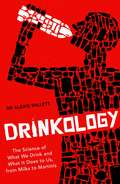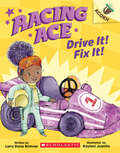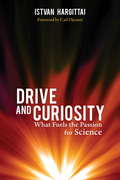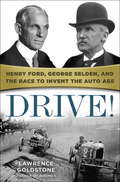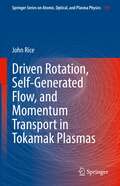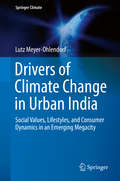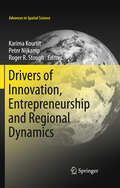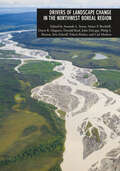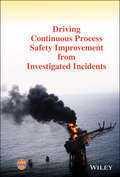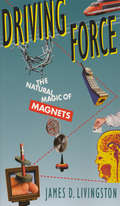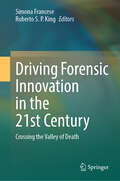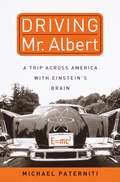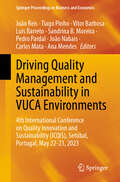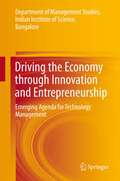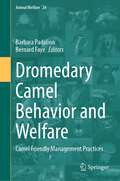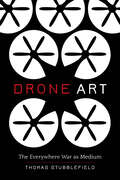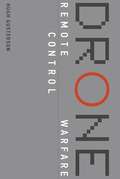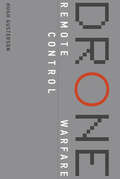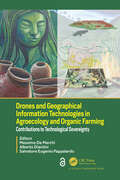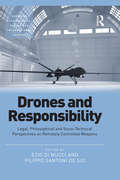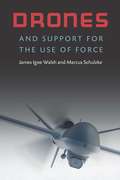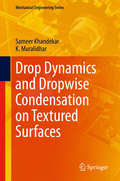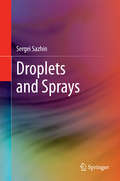- Table View
- List View
Drinkology: The Science of What We Drink and What It Does to Us, from Milks to Martinis
by Dr Alexis WillettSHORTLISTED FOR THE 2019 ANDRÉ SIMON FOOD & DRINK BOOK AWARDS'Like a new Bill Bryson, she offers an easy sharing of deep knowledge, with humour, where one learns things in a gentle way without it feeling like learning.' Dan Jago, judge of the André Simon Food & Drink Book Awards'Hot or cold, caffeinated, alcoholic, sweet or not, this book provides a fascinating cultural history of our favourite drinks, and explores the science (or not) underpinning their many health claims. A wonderful read!'Dr Giles Yeo, author of Gene Eating'A truly engaging read. By dispelling common health misconceptions and debunking bad science, Drinkology arms us with information to make better choices about what we drink, not just what we eat.'Ian Marber'Very engaging and entertaining . . . a clear guide to everything we need to know about drinks, from water to milk, tea, alcohol and beyond. Dr Willett dispels common myths and fads and sets the record straight . . . allowing us to make fully informed choices. A fascinating deep dive into the science behind everything we drink.'Elisabeth Cresta and Caroline Day, founders of Fight the Fads Do you really know what you are drinking? Are you sure? We all consume many drinks every day, often without thinking. Perhaps we're just thirsty, perhaps we need something to wake us up, perhaps we need something to relax us at the end of the day. But have you ever stopped to wonder what exactly is in that chai latte you're guzzling or just what those added electrolytes in your bottled water are supposed to do? Whether it's a simple glass of water or early morning espresso, the finest champagne or energy drink the morning after, all drinks have an impact on our body in one way or another. Drinkology distils the scientific evidence to see if we can get to the bottom of questions, such as:Is a regular glass of wine good for our health or not?Should we worry about energy drinks?Is fluoride in our tap water harmful?How do non-dairy milks compare with each other?What's the secret to the perfect cup of tea?Are fermented drinks and probiotics the answer to all our worries?Is there such a thing as a 'superdrink'?Whether you want to discover the true benefits of wellness drinks, find out if sulphites in wine really cause headaches, or are just sick of the pseudoscience behind the marketing of what we consume, this book is for you. Drinkology is a scientific digest of many of the world's most popular beverages and may just change the way you drink.
Drip! Drop! How Water Gets to Your Tap
by Barbara Seuling Nancy TobinExplains the water cycle and introduces experiments.
Drive It! Fix It!: An Acorn Book (Racing Ace #1)
by Larry Dane BrimnerAce is ready to race her new car!Pick a book. Grow a Reader!This series is part of Scholastic's early reader line, Acorn, aimed at children who are learning to read. With easy-to-read text, a short-story format, plenty of humor, and full-color artwork on every page, these books will boost reading confidence and fluency. Acorn books plant a love of reading and help readers grow!Ace has built her very own car and is getting ready to race! After oiling the wheels and kicking the tires, Ace sets out to win. But when a missing part and a rut in the middle of the track threaten to keep her in last place, Ace has to think fast to finish strong -- and come out on top!With Larry Dane Brimner's simple text and Kaylani Juanita's full-color artwork on every page, this fast-paced, action-packed book is perfect for new readers!
Drive and Curiosity
by Istvan HargittaiWhat motivates those few scientists who rise above their peers to achieve breakthrough discoveries? This book examines the careers of fifteen eminent scientists who achieved some of the most notable discoveries of the past century, providing an insider's perspective on the history of twentieth century science based on these engaging personality profiles. They include:* Dan Shechtman, the 2011 Nobel laureate and discoverer of quasicrystals;* James D. Watson, the Nobel laureate and codiscoverer of the double helix structure of DNA;* Linus Pauling, the Nobel laureate remembered most for his work on the structure of proteins;* Edward Teller, a giant of the 20th century who accomplished breakthroughs in understanding of nuclear fusion; * George Gamow, a pioneering scientist who devised the initially ridiculed and now accepted Big Bang.In each case, the author has uncovered a singular personality characteristic, motivational factor, or circumstance that, in addition to their extraordinary drive and curiosity, led these scientists to make outstanding contributions. For example, Gertrude B. Elion, who discovered drugs that saved millions of lives, was motivated to find new medications after the deaths of her grandfather and later her fiancé. F. Sherwood Rowland, who stumbled upon the environmental harm caused by chlorofluorocarbons, eventually felt a moral imperative to become an environmental activist. Rosalyn Yalow, the codiscoverer of the radioimmunoassay always felt she had to prove herself in the face of prejudice against her as a woman. These and many more fascinating revelations make this a must-read for everyone who wants to know what traits and circumstances contribute to a person's becoming the scientist who makes the big breakthrough.
Drive!: Henry Ford, George Selden, and the Race to Invent the Auto Age
by Lawrence GoldstoneFrom the acclaimed author of Birdmen comes a revelatory new history of the birth of the automobile, an illuminating and entertaining true tale of invention, competition, and the visionaries, hustlers, and swindlers who came together to transform the world. In 1900, the Automobile Club of America sponsored the nation's first car show in New York's Madison Square Garden. The event was a spectacular success, attracting seventy exhibitors and nearly fifty thousand visitors. Among the spectators was an obscure would-be automaker named Henry Ford, who walked the floor speaking with designers and engineers, trying to gauge public enthusiasm for what was then a revolutionary invention. His conclusion: the automobile was going to be a fixture in American society, both in the city and on the farm--and would make some people very rich. None, he decided, more than he. Drive! is the most complete account to date of the wild early days of the auto age. Lawrence Goldstone tells the fascinating story of how the internal combustion engine, a "theory looking for an application," evolved into an innovation that would change history. Debunking many long-held myths along the way, Drive! shows that the creation of the automobile was not the work of one man, but very much a global effort. Long before anyone had heard of Henry Ford, men with names like Benz, Peugeot, Renault, and Daimler were building and marketing the world's first cars. Goldstone breathes life into an extraordinary cast of characters: the inventors and engineers who crafted engines small enough to use on a "horseless carriage"; the financiers who risked everything for their visions; the first racers--daredevils who pushed rickety, untested vehicles to their limits; and such visionary lawyers as George Selden, who fought for and won the first patent for the gasoline-powered automobile. Lurking around every corner is Henry Ford, a brilliant innovator and an even better marketer, a tireless promoter of his products--and of himself. With a narrative as propulsive as its subject, Drive! plunges us headlong into a time unlike any in history, when near-manic innovation, competition, and consumerist zeal coalesced to change the way the world moved. Advance praise for Drive!"A wonderful, story-filled saga of the early days of the auto age . . . Readers will be swept up in his vivid re-creation of a bygone era. . . . 'Horse Is Doomed,' read one headline in 1895. This highly readable popular history tells why."--Kirkus Reviews (starred reviews)"A splendid dissection of the Selden/Ford patent face-off and its place in automotive historiography, this work will be enjoyed by business, legal, transportation, social, and intellectual historians; general readers; and all libraries."--Library Journal (starred review) "This book contains the great names in automotive history--the Dodge brothers, Barney Oldfield, all the French (they seemed, until Ford, to lead the Americans in development of the vehicle)--and it is fascinating. . . . An engaging new take on the history of technological innovation."--Booklist "Business history as you have never read it before. Lawrence Goldstone tells the tale of the important but now forgotten legal fight over the patent for the automobile. With more plot twists than a murder mystery and a cast of well-known industrial titans, Drive! takes the reader down the road from the dawning age of the automobile, when Henry Ford's dream almost turned into a nightmare."--James McGrath Morris, author of Pulitzer: A Life in Politics, Print, and PowerFrom the Hardcover edition.
Driven Rotation, Self-Generated Flow, and Momentum Transport in Tokamak Plasmas (Springer Series on Atomic, Optical, and Plasma Physics #119)
by John RiceThis book provides a comprehensive look at the state of the art of externally driven and self-generated rotation as well as momentum transport in tokamak plasmas. In addition to recent developments, the book includes a review of rotation measurement techniques, measurements of directly and indirectly driven rotation, momentum sinks, self-generated flow, and momentum transport. These results are presented alongside summaries of prevailing theory and are compared to predictions, bringing together both experimental and theoretical perspectives for a broad look at the field. Both researchers and graduate students in the field of plasma physics will find this book to be a useful reference. Although there is an emphasis on tokamaks, a number of the concepts are also relevant to other configurations.
Drivers of Climate Change in Urban India: Social Values, Lifestyles, and Consumer Dynamics in an Emerging Megacity (Springer Climate)
by Lutz Meyer-OhlendorfThis study transcends the homogenizing (inter-)national level of argumentation (‘rich’ versus ‘poor’ countries), and instead looks at a sub-national level in two respects: (1) geographically it focuses on the rapidly growing megacity of Hyderabad; (2) in socio-economic terms the urban population is disaggregated by taking a lifestyle typology approach. For the first time, the lifestyle concept – traditionally being used in affluent consumer societies – is applied to a dynamically transforming and socially heterogeneous urban society. Methodically, the author includes India-specific value orientations as well as social practices as markers of social structural differentiation. The study identifies differentials of lifestyle-induced GHG emissions (carbon footprints) and underlines the ambiguity of a purely income based differentiation with regard to the levels of contribution to the climate problem.
Drivers of Innovation, Entrepreneurship and Regional Dynamics
by Roger R. Stough Peter Nijkamp Karima KourtitThe need for informed and effective insights into key concepts and models of regional development and growth, from an endogenous growth perspective, has risen over the past decade. These recent advances address in particular local and regional assets and characteristics comprising inter alia creativity, knowledge, innovation forces and entrepreneurship. Access to and exploitation of these modern forms of human and social capital are of paramount importance for the dynamic regional economic environment in a city or region. This volume offers an overview and critical treatment of the spatial-economic roots, opportunities and impacts of new growth strategies, mainly from an evidence-based perspective. In the various contributions to this volume, relevant findings and strategic options are interpreted and discussed from both an analytical and a policy perspective to help cultivate creativity, human capital development and innovation as well as entrepreneurial activity, with a view to exploit the drivers of economic development, in order to strengthen the competitive edge of cities and regions.
Drivers of Landscape Change in the Northwest Boreal Region
by Valerie BarberThe northwest boreal region (NWB) of North America is a land of extremes. Extending more than 1.3 million square kilometers (330 million acres), it encompasses the entire spectrum between inundated wetlands below sea level to the tallest peak in North America. Permafrost gradients span from nearly continuous to absent. Boreal ecosystems are inherently dynamic and continually change over decades to millennia. The braided rivers that shape the valleys and wetlands continually change course, creating and removing vast wetlands and peatlands. Glacial melt, erosion, fires, permafrost dynamics, and wind-blown loess are among the shaping forces of the landscape. As a result, species interactions and ecosystem processes are shifting across time. The NWB is a data-poor region, and the intention of the NWB Landscape Conservation Cooperative is to determine what data are not available and what data are available. For instance, historical baseline data describing the economic and social relationships in association with the ecological condition of the NWB landscape are often lacking. Likewise, the size and remoteness of this region make it challenging to measure basic biological information, such as species population sizes or trends. The paucity of weather and climate monitoring stations also compound the ability to model future climate trends and impacts, which is part of the nature of working in the north. The purpose of this volume is to create a resource for regional land and resource managers and researchers by synthesizing the latest research on the historical and current status of landscape-scale drivers (including anthropogenic activities) and ecosystem processes, future projected changes of each, and the effects of changes on important resources. Generally, each chapter is coauthored by researchers and land and natural resource managers from the United States and Canada.
Driving Continuous Process Safety Improvement From Investigated Incidents
by CCPS (Center for Chemical Process Safety)New perspectives on how to share the lessons learned from publicly investigated process safety incidents Driving Continuous Process Safety Improvement from Investigated Incidents offers a novel view on how to successfully communicate process safety incident lessons. This book comes from the Center for Chemical Process Safety (CCPS), providing learning models and sharing techniques. This important book: Offers guidelines for improving process safety performance by applying the lessons learned from publicly available incident investigations Presents the background for and recommends a continuous improvement learning model Provides scenario examples for using the model’s techniques and how to internalize the learnings Written for safety professionals and process safety consultants, Driving Continuous Process Safety Improvement from Investigated Incidents is a hands-on guide for adopting a model for successfully communicating the learnings from process safety incident investigations.
Driving Force: The Natural Magic of Magnets
by James D. LivingstonDriving Force unfolds the long and colorful history of magnets: how they guided (or misguided) Columbus; mesmerized eighteenth-century Paris but failed to fool Benjamin Franklin; lifted AC power over its rival, DC, despite all the animals, one human among them, executed along the way; led Einstein to the theory of relativity; helped defeat Hitler’s U-boats; inspired writers from Plato to Dave Barry. In a way that will delight and instruct even the nonmathematical among us, James Livingston shows us how scientists today are creating magnets and superconductors that can levitate high-speed trains, produce images of our internal organs, steer high-energy particles in giant accelerators, and—last but not least—heat our morning coffee. From the “new” science of materials to everyday technology, Driving Force makes the workings of magnets a matter of practical wonder. The book will inform and entertain technical and nontechnical readers alike and will give them a clearer sense of the force behind so much of the working world.
Driving Forensic Innovation in the 21st Century: Crossing the Valley of Death
by Simona Francese Roberto S. P. KingThis contributed volume offers a comprehensive and multifaceted understanding of the current forensic innovation, landscape, enablers, road blockers, and barriers to implementation. It also presents all aspects that need consideration to cross the valley of death between an idea and its successful implementation. It uniquely merges the technical and scientific aspects of some of the innovations that have been implemented across forensic science within the National and International landscape and with i) the necessary considerations to take into account on the road to success, such as business planning, data privacy, and legal and regulatory aspects, ii) the end-users perspective and iii) the industry perspective. Case studies illustrate "what success looks like" by discussing forensic innovations that have made it to the market and have subsequently impacted positively on criminal investigations. This book acts as a platform to facilitate the dialogue between key stakeholders in driving innovation namely academia, industry, and end-users as well as indicating a roadmap to facilitate practical developments, whilst serving as a revolutionary springboard to initiate an innovation-transforming paradigm shift. This volume is a valuable contribution to the field and is of great interest to graduates and researchers engaged in forensic science, forensic service providers and manufacturers as well as policymakers.
Driving Mr. Albert: a Trip Across America With Einstein's Brain
by Michael PaternitiDriving Mr. Albert chronicles the adventures of an unlikely threesome--a freelance writer, an elderly pathologist, and Albert Einstein's brain--on a cross-country expedition intended to set the story of this specimen-cum-relic straight once and for all.
Driving Quality Management and Sustainability in VUCA Environments: 4th International Conference on Quality Innovation and Sustainability (ICQIS), Setubal, Portugal, May 22-23, 2023 (Springer Proceedings in Business and Economics)
by João Reis Tiago Pinho Vítor Barbosa Luís Barreto Sandrina B. Moreira Pedro Pardal João Nabais Carlos Mata Ana MendesThis proceedings volume provides in-depth research in the fields of quality innovation, sustainability, and operations management. It features contributions from the 4th International Conference on Quality Innovation and Sustainability (ICQIS) that explore how research in quality and innovation boost sustainability and includes solutions to complex industrial problems presented by researchers, professionals, and managers in the field. It also examines the drivers of quality management and sustainability in VUCA environments, with a special focus on supply chain management and innovation. Featuring real business cases on quality and sustainability, this book is useful for researchers, scholars, students, and academics interested in quality management, supply chain management, circular economy, and sustainability.
Driving the Economy through Innovation and Entrepreneurship: Emerging Agenda for Technology Management
by Anjula Gurtoo K B Akhilesh R. Srinivasan Chiranjit Mukhopadhyay Parthasarathy Ramachandran Parameshwar P Iyer M Mathirajan M H Bala SubrahmanyaModern technologies are central to creation of wealth through business expansion leading to economic development. This is visible in the fast-paced technology-induced economic growth experienced by most countries, especially by rapidly growing economies such as India, China, Brazil, South Korea, among others. Increasing individual scientific contribution, nurturing entrepreneurial talent, promoting innovative competence, strategically prioritizing and investing in technologies and enhancing national economic wealth are some of the important Technology Management goals. Technology Management has emerged as a strategic and knowledge domain of interest to academicians, practitioners, and policy makers across the globe. Technology Management has also evolved into an inter-disciplinary concern which requires national and international collaborations and exchange of insights. Keeping this objective in mind the International Conference on Technology Management is organized by the Department of Management Studies, Indian Institute of Science, Bangalore, a leader in research and education in Technology Management for the last several decades. This conference aims at integrating experiences of academicians, industry leaders, Technology Managers and Innovators towards effective knowledge creation and economic development. The contributions of the present volume are presented at the International Conference on Technology Management-2012 during 18-20 July 2012.
Dromedary Camel Behavior and Welfare: Camel Friendly Management Practices (Animal Welfare #24)
by Bernard Faye Barbara PadalinoThis volume gives a comprehensive review on dromedary camel handling and management by respecting its welfare, which is a global first. Beyond that, it provides a new welfare assessment tool.Expert authors lay the groundwork for understanding the animals by covering domestication, camels´ behavioral repertoire and needs, as well as dromedary camel genetics and coping with production systems. Then, the reader is equipped with the latest expertise on good management practices in camel farms, including transport, feeding, housing from racing to dairy systems, and health and hygiene. Moreover, the impact of innovative reproduction techniques and, finally, slaughter are taken into account.Camels, long confined to desert areas and kept extensively, have recently faced changes in husbandry systems and their environment. Intensification and specialization for milk, meat or sport purpose, as well as new geographic conditions have had significant impact on camel welfare.This book is a must-read for all camel industry members, breeders, veterinarians, and researchers, who want to practice camel breeding and management while safeguarding the behavioral needs and welfare of these amazing animals.
Drone Art: The Everywhere War as Medium
by Thomas StubblefieldWhat happens when a drone enters a gallery or appears on screen? What thresholds are crossed as this weapon of war occupies everyday visual culture? These questions have appeared with increasing regularity since the advent of the War on Terror, when drones began migrating into civilian platforms of film, photography, installation, sculpture, performance art, and theater. In this groundbreaking study, Thomas Stubblefield attempts not only to define the emerging genre of "drone art" but to outline its primary features, identify its historical lineages, and assess its political aspirations. Richly detailed and politically salient, this book is the first comprehensive analysis of the intersections between drones, art, technology, and power.
Drone Wars
by Peter L. Bergen Daniel RothenbergDrones are the iconic military technology of many of today's most pressing conflicts. Drones have captured the public imagination, partly because they project lethal force in a manner that challenges accepted norms and moral understandings. Drone Wars presents a series of essays by legal scholars, journalists, government officials, military analysts, social scientists, and foreign policy experts. It addresses drones' impact on the ground, how their use adheres to and challenges the laws of war, their relationship to complex policy challenges, and the ways they help us understand the future of war. The book is a diverse and comprehensive interdisciplinary perspective on drones that covers important debates on targeted killing and civilian casualties, presents key data on drone deployment, and offers new ideas on their historical development, significance, and impact on law and policy.
Drone: Remote Control Warfare
by Hugh GustersonDrones are changing the conduct of war. Deployed at presidential discretion, they can be used in regular war zones or to kill people in such countries as Yemen and Somalia, where the United States is not officially at war. Advocates say that drones are more precise than conventional bombers, allowing warfare with minimal civilian deaths while keeping American pilots out of harm's way. Critics say that drones are cowardly and that they often kill innocent civilians while terrorizing entire villages on the ground. In this book, Hugh Gusterson explores the significance of drone warfare from multiple perspectives, drawing on accounts by drone operators, victims of drone attacks, anti-drone activists, human rights activists, international lawyers, journalists, military thinkers, and academic experts. Gusterson examines the way drone warfare has created commuter warriors and redefined the space of the battlefield. He looks at the paradoxical mix of closeness and distance involved in remote killing: is it easier than killing someone on the physical battlefield if you have to watch onscreen? He suggests a new way of understanding the debate over civilian casualties of drone attacks. He maps "ethical slippage" over time in the Obama administration's targeting practices. And he contrasts Obama administration officials' legal justification of drone attacks with arguments by international lawyers and NGOs.
Drone: Remote Control Warfare
by Hugh GustersonDrone warfare described from the perspectives of drone operators, victims of drone attacks, anti-drone activists, international law, military thinkers, and others. Drones are changing the conduct of war. Deployed at presidential discretion, they can be used in regular war zones or to kill people in such countries as Yemen and Somalia, where the United States is not officially at war. Advocates say that drones are more precise than conventional bombers, allowing warfare with minimal civilian deaths while keeping American pilots out of harm's way. Critics say that drones are cowardly and that they often kill innocent civilians while terrorizing entire villages on the ground. In this book, Hugh Gusterson explores the significance of drone warfare from multiple perspectives, drawing on accounts by drone operators, victims of drone attacks, anti-drone activists, human rights activists, international lawyers, journalists, military thinkers, and academic experts.Gusterson examines the way drone warfare has created commuter warriors and redefined the space of the battlefield. He looks at the paradoxical mix of closeness and distance involved in remote killing: is it easier than killing someone on the physical battlefield if you have to watch onscreen? He suggests a new way of understanding the debate over civilian casualties of drone attacks. He maps “ethical slippage” over time in the Obama administration's targeting practices. And he contrasts Obama administration officials' legal justification of drone attacks with arguments by international lawyers and NGOs.
Drones and Geographical Information Technologies in Agroecology and Organic Farming: Contributions to Technological Sovereignty
by Massimo De MarchiAlthough organic farming and agroecology are normally not associated with the use of new technologies, it’s rapid growth, new technologies are being adopted to mitigate environmental impacts of intensive production implemented with external material and energy inputs. GPS, satellite images, GIS, drones, help conventional farming in precision supply of water, pesticides, fertilizers. Prescription maps define the right place and moment for interventions of machinery fleets. Yield goal remains the key objective, integrating a more efficient use or resources toward an economic-environmental sustainability. Technological smart farming allows extractive agriculture entering the sustainability era. Societies that practice agroecology through the development of human-environmental co-evolutionary systems represent a solid model of sustainability. These systems are characterized by high-quality agroecosystems and landscapes, social inclusion, and viable economies. This book explores the challenges posed by the new geographic information technologies in agroecology and organic farming. It discusses the differences among technology-laden conventional farming systems and the role of technologies in strengthening the potential of agroecology. The first part reviews the new tools offered by geographic information technologies to farmers and people. The second part provides case studies of most promising application of technologies in organic farming and agroecology: the diffusion of hyperspectral imagery, the role of positioning systems, the integration of drones with satellite imagery. The third part of the book, explores the role of agroecology using a multiscale approach from the farm to the landscape level. This section explores the potential of Geodesign in promoting alliances between farmers and people, and strengthening food networks, whether through proximity urban farming or asserting land rights in remote areas in the spirit of agroecological transition. The Open Access version of this book, available at www.taylorfrancis.com, has been made available under a Creative Commons 4.0 license.
Drones and Responsibility: Legal, Philosophical and Socio-Technical Perspectives on Remotely Controlled Weapons (Emerging Technologies, Ethics and International Affairs)
by Ezio Di Nucci Filippo Santoni SioHow does the use of military drones affect the legal, political, and moral responsibility of different actors involved in their deployment and design? This volume offers a fresh contribution to the ethics of drone warfare by providing, for the first time, a systematic interdisciplinary discussion of different responsibility issues raised by military drones. The book discusses four main sets of questions: First, from a legal point of view, we analyse the ways in which the use of drones makes the attribution of criminal responsibility to individuals for war crimes more complicated and what adjustments may be required in international criminal law and in military practices to avoid ’responsibility gaps’ in warfare. From a moral and political perspective, the volume looks at the conditions under which the use of military drones by states is impermissible, permissible, or even obligatory and what the responsibilities of a state in the use of drones towards both its citizens and potential targets are. From a socio-technical perspective, what kind of new human machine interaction might (and should) drones bring and which new kinds of shared agency and responsibility? Finally, we ask how the use of drones changes our conception of agency and responsibility. The book will be of interest to scholars and students in (military) ethics and to those in law, politics and the military involved in the design, deployment and evaluation of military drones.
Drones and Support for the Use of Force
by Marcus Schulzke James Igoe WalshCombat drones are transforming attitudes about the use of military force. Military casualties and the costs of conflict sap public support for war and for political and military leaders. Combat drones offer an unprecedented ability to reduce these costs by increasing accuracy, reducing the risks to civilians, and protecting military personnel from harm. These advantages should make drone strikes more popular than operations involving ground troops. Yet many critics believe drone warfare will make political leaders too willing to authorize wars, weakening constraints on the use of force. Because combat drones are relatively new, these arguments have been based on anecdotes, a handful of public opinion polls, or theoretical speculation. Drones and Support for the Use of Force uses experimental research to analyze the effects of combat drones on Americans’ support for the use of force. The authors’ findings—that drones have had important but nuanced effects on support for the use of force—have implications for democratic control of military action and civil-military relations and provide insight into how the proliferation of military technologies influences foreign policy.
Drop Dynamics and Dropwise Condensation on Textured Surfaces (Mechanical Engineering Series)
by Sameer Khandekar K. MuralidharThis book is an expanded form of the monograph, Dropwise Condensation on Inclined Textured Surfaces, Springer, 2013, published earlier by the authors, wherein a mathematical model for dropwise condensation of pure vapor over inclined textured surfaces was presented, followed by simulations and comparison with experiments. The model factored in several details of the overall quasi-cyclic process but approximated those at the scale of individual drops. In the last five years, drop level dynamics over hydrophobic surfaces have been extensively studied. These results can now be incorporated in the dropwise condensation model.Dropwise condensation is an efficient route to heat transfer and is often encountered in major power generation applications. Drops are also formed during condensation in distillation devices that work with diverse fluids ranging from water to liquid metals. Design of such equipment requires careful understanding of the condensation cycle, starting from the birth of nuclei, followed by molecular clusters, direct growth of droplets, their coalescence, all the way to instability and fall-off of condensed drops. The model described here considers these individual steps of the condensation cycle. Additional discussions include drop shape determination under static conditions, a fundamental study of drop spreading in sessile and pendant configurations, and the details of the drop coalescence phenomena. These are subsequently incorporated in the condensation model and their consequences are examined. As the mathematical model is spread over multiple scales of length and time, a parallelization approach to simulation is presented. Special topics include three-phase contact line modeling, surface preparation techniques, fundamentals of evaporation and evaporation rates of a single liquid drop, and measurement of heat transfer coefficient during large-scale condensation of water vapor. We hope that this significantly expanded text meets the expectations of design engineers, analysts, and researchers working in areas related to phase-change phenomena and heat transfer.
Droplets and Sprays
by Sergei SazhinProviding a clear and systematic description of droplets and spray dynamic models, this book maximises reader insight into the underlying physics of the processes involved, outlines the development of new physical and mathematical models and broadens understanding of interactions between the complex physical processes which take place in sprays. Complementing approaches based on the direct application of computational fluid dynamics (CFD), Droplets and Sprays treats both theoretical and practical aspects of internal combustion engine process such as the direct injection of liquid fuel, subcritical heating and evaporation. Including case studies that illustrate the approaches relevance to automotive applications, it is also anticipated that the described models can find use in other areas such as in medicine and environmental science.
